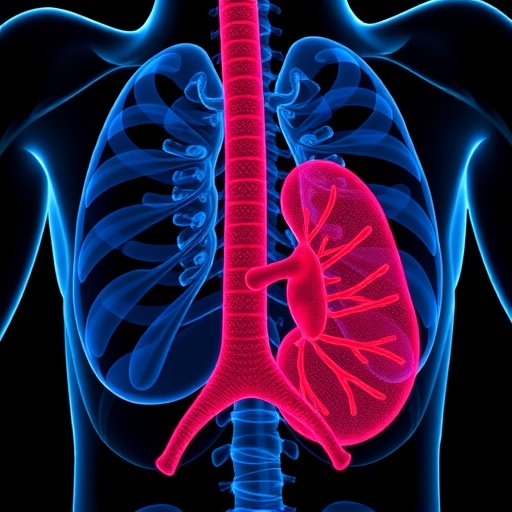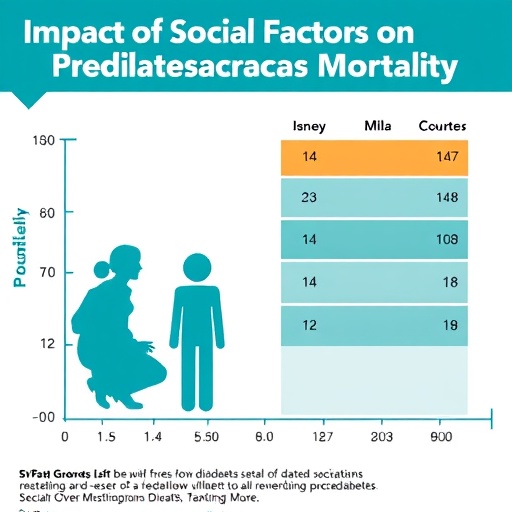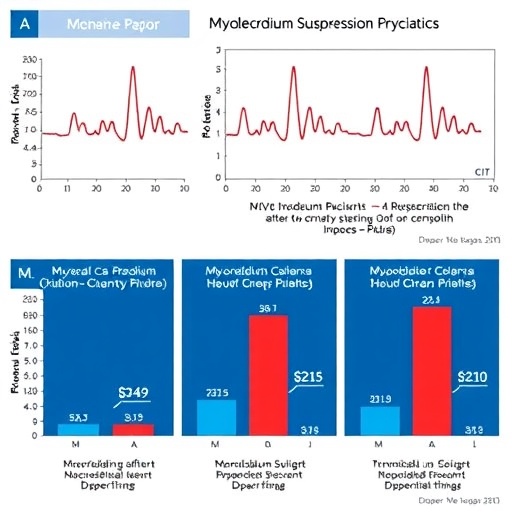
In a groundbreaking study published in Nature Communications, researchers have unveiled new insights into the molecular and immune landscape that predicts patient response to neoadjuvant axitinib therapy in renal cell carcinoma (RCC) complicated by venous tumor thrombus. This discovery marks a significant leap forward in the personalized treatment strategies for a subgroup of RCC patients who historically face grim prognoses due to vascular invasion by their tumors. The research, conducted by Wray, Paverd, Machado, and colleagues, meticulously dissects the angiogenic and immune factors that modulate therapeutic efficacy, providing a roadmap for clinicians to optimize neoadjuvant interventions.
Renal cell carcinoma is the most common form of kidney cancer, notorious for its ability to invade the venous system, including the renal vein and the inferior vena cava, forming what is known as a venous tumor thrombus. This vascular infiltration complicates surgical resection and often portends a poorer outcome. Targeted therapies, such as axitinib—a potent tyrosine kinase inhibitor that disrupts vascular endothelial growth factor receptors (VEGFRs)—have emerged as promising neoadjuvant treatments, aiming to shrink the tumor thrombus before surgery. However, response rates vary widely among patients, emphasizing the urgent need to understand the biological underpinnings governing sensitivity and resistance to axitinib.
The multidisciplinary team employed an integrative approach combining transcriptomic profiling, immunohistochemistry, and advanced computational analyses on tumor samples collected pre- and post-axitinib therapy. Their goal was to identify biomarkers—particularly those related to angiogenesis and immune cell infiltration—that could reliably forecast patient responses. Through this comprehensive evaluation, the investigators discovered that the expression patterns of certain angiogenic genes, alongside the spatial arrangement and subtype composition of immune cells within both the primary tumor and the thrombus, dictate therapeutic outcomes.
One of the pivotal findings highlighted in the study is the characterization of an angiogenic signature that enshrines a finely tuned balance between pro- and anti-angiogenic factors. Patients demonstrating a predominance of pro-angiogenic signaling components, such as VEGF-A and angiopoietin-2, showed variable responsiveness to axitinib, indicating that mere upregulation of these factors is insufficient to predict efficacy. Instead, the effective inhibition of VEGFR pathways appeared contingent on the concurrent presence of specific immune modulating processes within the tumor microenvironment.
Intriguingly, the immune contexture emerged as a decisive determinant of axitinib response. Tumors exhibiting an inflamed microenvironment, characterized by an abundance of cytotoxic CD8+ T cells and antigen-presenting dendritic cells, were more likely to respond favorably to neoadjuvant treatment. Conversely, tumors with an immunosuppressive milieu, rich in regulatory T cells (Tregs) and myeloid-derived suppressor cells (MDSCs), demonstrated resistance, pointing to the indispensable role of immune checkpoints and suppressor populations in mediating therapeutic outcomes.
The investigation further delved into the spatial heterogeneity between primary renal tumors and their associated venous thrombi. It was noted that the immune phenotypes in the thrombi were often distinct from those in the primary tumor bed, suggesting compartmentalized immune dynamics. This heterogeneity could explain the differential sensitivity sometimes observed between the primary lesion and the thrombus portion, underscoring the necessity for biopsy sampling from both sites to inform effective therapy design.
Advanced computational modeling enabled the team to integrate molecular and cellular data, generating a predictive algorithm with potential clinical utility. This model stratifies patients based on angiogenic and immune features, surmounting the limitations of conventional clinical staging and imaging. Such stratification can empower oncologists to preemptively identify those who would derive maximal benefit from axitinib neoadjuvant therapy, sparing non-responders from unnecessary toxicity and delays in definitive surgical intervention.
Moreover, the findings pave the way for combination therapies that target both angiogenesis and immune evasion mechanisms. The authors speculate that integrating immune checkpoint inhibitors alongside axitinib might synergize to overcome resistance mediated by immunosuppressive microenvironments. This concept resonates with burgeoning clinical evidence supporting combined targeted and immunotherapies in RCC, reflecting a paradigm shift toward multi-modal, precision oncology.
The implications of this study extend beyond RCC with venous thrombus, potentially influencing treatment algorithms for a variety of solid tumors exhibiting vascular invasion and reliance on angiogenic pathways. By illuminating the complex crosstalk between tumor vasculature and immune infiltrates, the work advocates for a holistic view of tumor biology that transcends singular molecular targets.
From a translational perspective, the study advocates for the integration of detailed molecular profiling into routine clinical workflows. It suggests that next-generation sequencing and immune profiling assays become indispensable tools for oncologists managing RCC patients with venous involvement. This approach aligns with the broader movement in oncology to harness biomarkers for real-time therapy adaptation, heralding an era of dynamic treatment personalization.
Importantly, this research leverages tissue samples obtained pre- and post-treatment, enabling a real-time glimpse into therapy-induced changes at molecular and cellular levels. This longitudinal insight is critical, as it reveals adaptive resistance mechanisms that could be pharmacologically targeted in subsequent treatment lines, thus sustaining therapeutic pressure on the tumor.
The study’s robust cohort design, combining clinical, pathologic, and molecular data from multiple centers, lends strong validity and reproducibility to the results. It exemplifies the power of collaborative, interdisciplinary research in tackling complex cancer challenges and delivering findings that are primed for clinical translation.
Future directions proposed by the researchers include expanding the predictive model to incorporate circulating biomarkers and imaging features, fostering non-invasive methods to monitor response dynamics. Such innovations could revolutionize surveillance strategies, enabling early detection of treatment failure and prompt therapeutic adjustments.
Furthermore, the elucidation of immune-suppressive pathways in resistant tumors invites exploration of novel agents targeting Tregs and MDSCs, potentially reversing immunosuppression and sensitizing tumors to both axitinib and immunotherapy. This angle holds promise for developing next-generation adjuvant regimens that improve survival in this high-risk RCC population.
Ultimately, this comprehensive study furnishes the oncology community with actionable insights that stand to refine neoadjuvant treatment paradigms, intensify the precision of RCC management, and inspire analogous investigations in other malignancies. The unveiling of angiogenic and immune predictors not only deepens our understanding of tumor biology in the context of vascular invasion but also empowers clinicians with tools to deliver more effective, personalized care.
As kidney cancer incidence continues to rise worldwide, innovations like these are essential to curtail morbidity and mortality. Harnessing the interplay between angiogenesis and immunity exemplifies the nuanced approach needed to conquer aggressive cancers that exploit their microenvironment for growth and dissemination.
In sum, the convergence of molecular biology, immunology, and clinical oncology represented by this work epitomizes the future of cancer therapy: integrative, predictive, and patient-centric. By leveraging biomarkers to match treatments to tumor biology, researchers and clinicians can finally close the gap between laboratory discoveries and improved patient outcomes in renal cell carcinoma complicated by venous tumor thrombus.
Subject of Research: Angiogenic and immune predictors of neoadjuvant axitinib response in renal cell carcinoma with venous tumour thrombus
Article Title: Angiogenic and immune predictors of neoadjuvant axitinib response in renal cell carcinoma with venous tumour thrombus
Article References:
Wray, R., Paverd, H., Machado, I. et al. Angiogenic and immune predictors of neoadjuvant axitinib response in renal cell carcinoma with venous tumour thrombus.
Nat Commun 16, 3870 (2025). https://doi.org/10.1038/s41467-025-58436-8
Image Credits: AI Generated
Tags: angiogenic factors in renal cancerAxitinib response predictionimmune landscape in cancer therapykidney cancer thrombusmolecular mechanisms of therapeutic responseneoadjuvant therapy insightspersonalized treatment strategiesrenal cell carcinoma researchtargeted therapies for kidney cancertumor thrombus surgical challengestyrosine kinase inhibitors in oncologyvascular invasion in RCC





